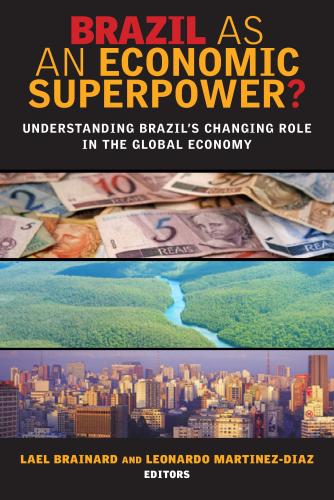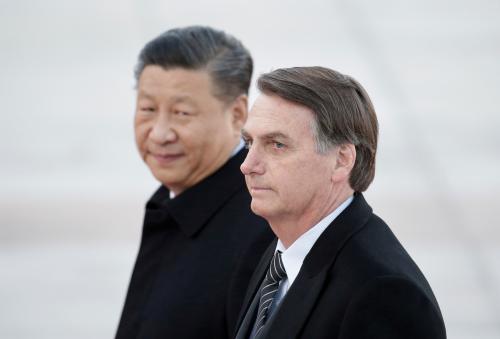As thousands of protesters descended on the three main houses of political power in Brasília on Sunday afternoon, the parallels between the January 6, 2021 attack on the U.S. Capitol and the events unfolding in Brazil’s capital were undeniable and widely discussed in the media. In many ways these comparisons were also entirely predictable: Former Brazilian President Jair Bolsonaro had followed former U.S. President Donald Trump’s playbook throughout much of his tenure in office. He rose to prominence as a pugnacious right-wing populist, did not shy away from embracing authoritarianism, spent his presidency lamenting “fake news,” and made repeated and baseless claims of fraud designed to undermine the integrity of Brazil’s elections. Both countries also experienced steady declines in rule of law performance during their respective tenures.
Despite what now seems like an inevitable finale, in the months after Bolsonaro’s defeat, Brazil watchers remained cautiously hopeful that a peaceful transition of power might be possible without major incident — and, for the most part, it was. In the aftermath of the election, Bolsonaro did not directly concede, but did authorize a presidential transition. Many Bolsonaro allies in elected office signaled their commitment to serving in “the opposition.” And although pro-Bolsonaro protests throughout the country remained a constant feature, political demonstrations in Brazil are fairly common and the security sector had successfully thwarted at least one particularly troubling incident.
Importantly, these demonstrations did not seem to feature the top-down mobilization that characterized the aftermath of the 2020 elections in the United States. In his final presidential statement, Bolsonaro urged supporters to accept their current reality. He had tried to find a way forward within the bounds of the Constitution, he told them, but ultimately, “[w]e live in a democracy or we don’t…No one wants an adventure.”
Amid heightened security and flanked by citizens representing the diversity of the Brazilian population, Luiz Inacio Lula da Silva was inaugurated earlier this month as the 39th president of Brazil. Meanwhile, Bolsonaro had been captured on camera in Florida, dining at Kentucky Fried Chicken and shopping at the Southern grocery store chain Publix (whose heiress had been willing to contribute up to $3 million to January 6 protests). These viral images sparked jokes about the former president’s status as a “temporary Florida man” and raised questions about his decision to flee Brazil before losing prosecutorial immunity for several legal investigations.
That a violent uprising by Bolsonaro supporters would ultimately descend upon Brasília is unsurprising, given two years of warning. But that it came when it did — after President Lula’s peaceful inauguration and Bolsonaro’s departure from Brazil — makes it both more puzzling and distinct from the January 6 attack on the Capitol. While Brazil’s federal institutions have admirably held the line against anti-democratic forces, what is now abundantly clear is that the embrace of authoritarianism has found a foothold in a country that 38 years ago emerged from repressive military rule. Although Bolsonaro’s direct role — if any — in Sunday’s attack remains unclear, the authoritarian norms that precipitated it have seemingly become entrenched amongst a subset of the population, perhaps even without the overt backing of the former president.
A different kind of insurrection
As the attack unfolded in Brasília, Congress was not in session, and federal buildings were largely vacant. With the transfer of power complete, the assault on the Superior Federal Court, National Congress, and the presidential palace seemed without clear purpose or organization. While rioters offered vague justification about occupying the building until the military intervened to overturn the election, they seemed to primarily focus on ransacking the place. Videos and images of Bolsonaro supporters bashing windows, destroying works of art, looting government documents, lighting fire to carpets, and even defecating on desks circulated widely online, often shared by those defacing federal property. There were even concerns that Bolsonaro supporters had made off with the original copy of the 1988 Brazilian Constitution, which later proved to only be a replica.
Unlike in the United States, the actions of these bolsonaristas did not directly threaten the lives of elected officials or seek to stop a constitutional process. But they did represent a clear demonstration of their disdain for democracy, laying bare the underlying authoritarian impulses motivating at least some of the former president’s supporters. They also highlighted the clear power of disinformation to mobilize even just a small fraction of partisans, who with thousands of rabid supporters committed destabilizing and destructive acts of violence.
What is more alarming about the events in Brasília is the total complacency of local government and public security officials from the Federal District (DF). Unlike Washington, D.C., the Federal District — home to Brasília — has the governing capabilities of both a state and municipality, and security forces within the DF are responsible for protecting federal buildings. Yet while the attack unfolded, Bolsonaro supporters met surprisingly limited resistance. Police officers — who are among the best paid in Brazil — were caught on camera chatting with protesters and buying coconut water.
Before the invasion, Brazil’s intelligence agency (which has reportedly become highly politicized) had warned the DF government of potential “violent acts” due to an unusual number of chartered buses headed for the capital, and messages on Telegram, WhatsApp, and other online networks calling for smaller protests around the country to descend on Brasília. Although a plan was in place to contain protesters, District-level officials purportedly relaxed their response strategy last minute, despite prevailing intelligence threats. While the role of the DF’s elected officials in these attacks is currently an open question, the now dismissed secretary of public security and the governor of the Federal District, both aligned with former President Bolsonaro, seem to have ignored these warnings.
Although the District-level government failed to meet the challenge, Brazil’s federal institutions once again showed their resilience to anti-democratic attacks, despite their relative youth. After news of the invasion broke, Lula declared a federal intervention of the District’s public security. With congressional approval, this allows the federal government to control public security until the end of the month. Alongside other federal forces, the military eventually intervened, drawing cheers from Bolsonaro supporters, but did so only to clear protesters from federal buildings (importantly, several military officials reportedly participated in the vandalism, highlighting clear internal divisions amongst Brazil’s armed forces). The Supreme Federal Tribunal Court also swiftly suspended the governor of the DF for 90 days, pending an investigation into his “painful absence” during the attack. Somewhere between 200 and 400 people were arrested immediately, and less than 24 hours later, the federal government had detained more than 1,500 people for questioning about their involvement in the attempted coup, with more arrests underway.
Investigations have already begun to identify individuals who breached federal property and uncover financial networks that helped charter buses from around Brazil. Eventually, investigators will turn to probing the culpability of elected officials. Precedent makes the prosecution of politicians a viable path, as Lula himself experienced after he left the presidency in 2011. A day after the assault, the heads of the three branches of the federal government released a joint statement of solidarity and “in repudiation of yesterday’s coup acts.” This quick action is due in part to the fact that Bolsonaro is no longer in power and, as a result, does not control the levers of the federal government. It may also be due to the fact that threats of a potential January 6-style event had been long anticipated, particularly given Bolsonaro’s warning that his future held one of three options: “being arrested, killed, or victory.”
The road to recovery
Despite widespread public disapproval of the attack earlier this week, and an outpouring of pro-democracy demonstrations following the riot, it would be unwise to celebrate the failed coup attempt as a death knell for bolsonarismo or anti-democratic forces in Brazil. After all, both found strong footing even without the overt backing of the former president. Although the recent presidential elections may have revitalized Brazil’s hobbled democracy, Bolsonaro’s presidency did serious damage to undermine the perceived legitimacy of democratic institutions and electoral processes.
As the Brazilian people move forward in the aftermath of the unprecedented attack, the U.S. experience offers a flawed blueprint to follow, or an opportunity to chart a different course. While the U.S. Department of Justice has continued to successfully prosecute January 6 insurrectionists, thus far higher-ups in Trump’s circle have mostly evaded accountability, and they remain a powerful force in the new U.S. Congress. The distinct elements of January 8, 2023 have in some ways already set Brazil on its own trajectory. Yet some clear similarities remain. Hyperpartisanship, the erosion of trust in legacy media, distrust of elections, and the narrow victories of Biden and Lula represent clear challenges for both presidents. With Lula now scheduled to visit Washington in early February and the two leaders reaffirming their commitment to a “permanent dialogue…to strengthen democracy,” Brazil and the United States have an important — and perhaps existential — opportunity for collaboration.
The Brookings Institution is committed to quality, independence, and impact.
We are supported by a diverse array of funders. In line with our values and policies, each Brookings publication represents the sole views of its author(s).












Commentary
Anti-democratic sentiment boils over in Brazil
January 12, 2023